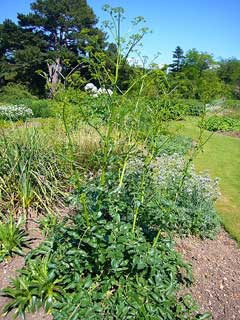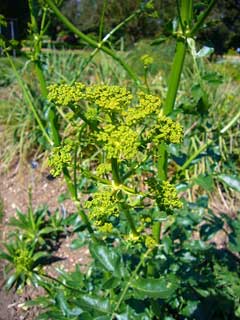 |
|
http://commons.wikimedia.org/wiki/User:Magnus_Manske |
 |
| http://commons.wikimedia.org/wiki/User:Magnus_Manske |
Translate this page:
Summary
Physical Characteristics

 Opopanax chironium is a PERENNIAL growing to 1.8 m (6ft).
Opopanax chironium is a PERENNIAL growing to 1.8 m (6ft).
See above for USDA hardiness. It is hardy to UK zone 6 and is not frost tender. It is in leaf from October to August, in flower from June to July, and the seeds ripen in August. The species is hermaphrodite (has both male and female organs) and is pollinated by Insects. The plant is self-fertile.
Suitable for: light (sandy), medium (loamy) and heavy (clay) soils and prefers well-drained soil. Suitable pH: mildly acid, neutral and basic (mildly alkaline) soils. It cannot grow in the shade. It prefers dry or moist soil.
UK Hardiness Map
US Hardiness Map
Synonyms
Malabaila opopanax.
Plant Habitats
Cultivated Beds;
Edible Uses
Edible Parts:
Edible Uses: Gum
None known
References More on Edible Uses
Medicinal Uses
Plants For A Future can not take any responsibility for any adverse effects from the use of plants. Always seek advice from a professional before using a plant medicinally.
Antispasmodic Deobstruent
The gum (an oleo resin according to one report) that is obtained from the base of the stems is antispasmodic and deobstruent[4]. It is nowadays considered to be a medium of feeble powers though it was at one time widely used in the treatment of menstrual disorders, asthma, chronic visceral afflictions etc[4].
References More on Medicinal Uses
The Bookshop: Edible Plant Books
Our Latest books on Perennial Plants For Food Forests and Permaculture Gardens in paperback or digital formats.

Edible Tropical Plants
Food Forest Plants for Hotter Conditions: 250+ Plants For Tropical Food Forests & Permaculture Gardens.
More

Edible Temperate Plants
Plants for Your Food Forest: 500 Plants for Temperate Food Forests & Permaculture Gardens.
More

More Books
PFAF have eight books available in paperback and digital formats. Browse the shop for more information.
Shop Now
Other Uses
Gum
A gum is obtained through incisions in the roots at the base of the stems[4]. It is used in perfumery[1, 46, 61] and also in medicines[171]. The gum is inflammable, burning brightly[4].
Special Uses
References More on Other Uses
Cultivation details
An easily grown plant, it succeeds in any good garden soil[1]. It can tolerate very considerable neglect, some plants we were growing were left to fend for themselves in very dense weed growth and survived well for 8 years before being moved to another site[K]. We are not sure how hardy this plant is, but the foliage has withstood short periods of temperatures down to -6°c with us[K]. A warm climate is necessary in order to produce good quality gum[4]. Plants seem to be very tolerant of root disturbance, specimens that had been growing for 4 years in one site grew away very well when transplanted as they came into growth in late autumn[K].
References Carbon Farming Information and Carbon Sequestration Information
Temperature Converter
Type a value in the Celsius field to convert the value to Fahrenheit:
Fahrenheit:
The PFAF Bookshop
Plants For A Future have a number of books available in paperback and digital form. Book titles include Edible Plants, Edible Perennials, Edible Trees,Edible Shrubs, Woodland Gardening, and Temperate Food Forest Plants. Our new book is Food Forest Plants For Hotter Conditions (Tropical and Sub-Tropical).
Shop Now
Plant Propagation
Seed - sow spring in situ. If seed is in short supply then it is best to sow it in a pot in the greenhouse in early spring. Prick out the seedlings into individual pots when they are large enough to handle and plant them out in early summer.
Other Names
If available other names are mentioned here
Native Range
TEMPERATE ASIA: Turkey EUROPE: Albania, Bulgaria, Greece, Croatia, Italy (incl. Sardinia, Sicily), North Macedonia, Montenegro, Romania, Slovenia, Spain, France
Weed Potential
Right plant wrong place. We are currently updating this section.
Please note that a plant may be invasive in one area but may not in your area so it's worth checking.
Conservation Status
IUCN Red List of Threatened Plants Status :

Growth: S = slow M = medium F = fast. Soil: L = light (sandy) M = medium H = heavy (clay). pH: A = acid N = neutral B = basic (alkaline). Shade: F = full shade S = semi-shade N = no shade. Moisture: D = dry M = Moist We = wet Wa = water.
Now available:
Food Forest Plants for Mediterranean Conditions
350+ Perennial Plants For Mediterranean and Drier Food Forests and Permaculture Gardens.
[Paperback and eBook]
This is the third in Plants For A Future's series of plant guides for food forests tailored to
specific climate zones. Following volumes on temperate and tropical ecosystems, this book focuses
on species suited to Mediterranean conditions—regions with hot, dry summers and cool, wet winters,
often facing the added challenge of climate change.
Read More
Expert comment
Author
(L.)Koch.
Botanical References
50
Links / References
For a list of references used on this page please go here
Readers comment
© 2010, Plants For A Future. Plants For A Future is a charitable company limited by guarantee, registered in England and Wales. Charity No. 1057719, Company No. 3204567.